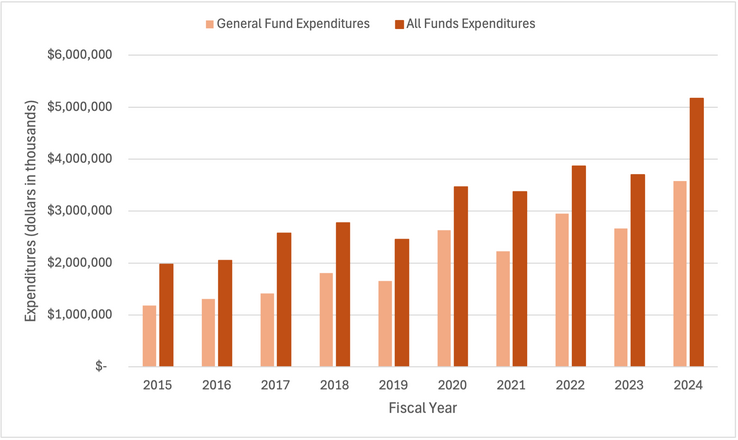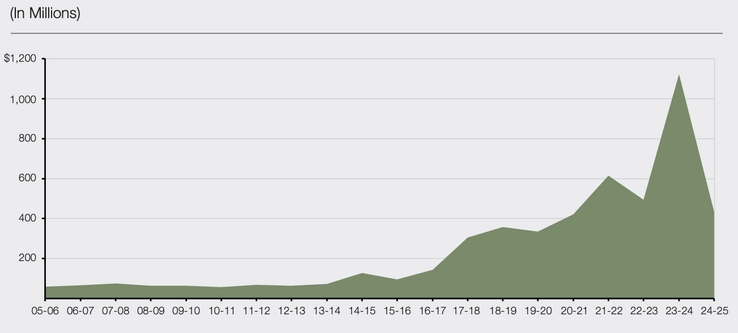This article is the second in a series examining climate adaptation and hazard mitigation financing at the federal, state, and local levels. Part 1 looked at the gaps resulting from recent cuts to FEMA funding. Part 3 of this series will examine local funding tools for hazard mitigation and climate adaptation.
Over the past decade, California has experienced 7 of its 10 most destructive wildfires, including the 2018 Camp Fire, the deadliest with 85 casualties, and the 2025 Eaton and Palisades fires, the costliest in property and capital losses at an estimated $76 billion to $131 billion. Longer, more intense fire seasons caused by climate change have forced the state to triple spending for wildfire protection, management, and response over the last decade. Despite this investment, the state is still underinvesting in wildfire resilience activities like vegetation management (prescribed burns, fuel breaks, defensible space, etc.), home hardening, adopting fire-wise land use and building codes, and community preparedness, though recent state policy actions have tried to address this gap. The goal of wildfire resilience activities is to protect lives and property, natural habitats, and recreational spaces while supporting regional economies.
A 2025 Resources for the Future report estimated that California would need $225 million (lowest estimate) to $1.8 billion (highest estimate) annually for wildfire resilience projects focused on just vegetation management over the next 10 years to address the state’s greatest wildfire risks. Combined current spending by the state and federal government is enough to address the lowest cost estimate, but, according to the report, implementing fuel treatments throughout all moderate to high-risk wildfire areas within the state would require a 100 to 200 percent increase in combined federal and state annual spending for wildfire resilience.
Resilience investments should be a no-brainer. According to the U.S. Chamber of Commerce, every $1 spent on resilience can save $13 in avoided economic costs, damages, and cleanup.
With recent cancellations of federal FEMA funding — a major source of grants for state and local climate adaptation and hazard resilience projects — California must expand state investment in climate resilience initiatives. The state knows firsthand the importance of taking proactive action to address climate change in the case of wildfire risk. Now it must firm up its commitments by continuing to strengthen its wildfire resilience investments especially for vegetation management and home hardening.
Wildfire Investments: A Decade of Growth
The Department of Forestry and Fire Protection (CAL FIRE) oversees fire protection, natural resource management, and emergency response across 31 million acres of state- and privately owned land, known as state responsibility areas (SRAs). City and county fire departments manage local responsibility areas (LRAs) in coordination with the State Fire Marshal, which operates under CAL FIRE. As a regulatory agency, CAL FIRE sets and enforces standards for building safety and timber harvesting, and it develops fire hazard severity zone maps for both SRAs and LRAs. Other agencies, such as the Office of Emergency Services, the Department of Conservation, the Department of Parks and Recreation, and numerous conservancies manage forest health and state grant programs.
CAL FIRE, like many other government agencies, relies on three main state funding sources: the General Fund, the Greenhouse Gas Reduction Fund, and state bonds. During budget shortfalls, these three funding sources provide flexibility in the budget, allowing the state to reallocate resources where they are most needed. Although this flexibility is beneficial in years of budget deficit, it can also lead the state to kick the can down the road when it comes to funding critical wildfire resilience needs.
From 2015 to 2024, CAL FIRE’s annual funding surged from approximately $1.98 billion to $5.17 billion, nearly tripling the state’s investments in wildfire resilience and response in just a decade. With this growth, CAL FIRE has expanded its workforce by adding 1,800 full-time and 600 seasonal positions annually over the last five years. Although this year’s budget deficit did lead to cuts of about $1 billion for CAL FIRE, Governor Newsom also signed a $2.5 billion disaster relief package in January 2025 to support recovery from the Los Angeles fires.
CAL FIRE Expenditures, Fiscal Years 2015–2024

Note: Dollars are in thousands. “All Funds” includes the General Fund, Greenhouse Gas Reduction Fund, Bonds, and other funds.
Source: SPUR analysis of FY 2015-2024 California Enacted Budget Detail.
The General Fund — the state’s discretionary operating fund covering annual expenses for essential programs — contributes a significant portion (50% to 70%) of CAL FIRE’s total expenditures. This sustained investment of state discretionary funds demonstrates a strong commitment to wildfire management, despite fluctuations in the budget.
The Greenhouse Gas Reduction Fund (GGRF), established through the state’s Cap-and-Invest Program, formerly known as the Cap-and-Trade Program, receives revenue from greenhouse gas emissions auction proceeds, which are earmarked for environmental and climate-related initiatives. In 2024, the state allocated $234 million from the GGRF for wildfire resilience. With Cap-and-Trade expiring in 2030, negotiations to extend the program through 2045 appear to have been successful. Lawmakers will continue to negotiate future allocations, but already wildfire prevention is listed as a top priority.
And additional funds are on the way. In November 2024, California voters approved Proposition 4, the state Climate Bond, authorizing $10 billion for a wide range of environmental projects, including $1.5 billion for wildfire resilience.
Wildfire Resilience: More Investment Needed
Over the past decade, the state also quadrupled its investment in CAL FIRE’s wildfire resilience and prevention programs (excluding fire response) from about $100 million in 2015–16 to an estimated $440 million in 2024–2025, down from a high of about $1.1 billion in 2023–2024. Funding for other departments that implement wildfire resilience programs — like state conservancies — has also increased in recent years. Despite this increase, the state’s investment in CAL FIRE’s resilience efforts was only 8.5% of the agency’s total expenditure budget in FY 2024–2025.
Increasing CalFire Wildfire Resilience and Prevention Spending
Until recent years, the state historically underinvested in resilience activities such as forest health, prescribed burns, defensible space, science research, and home hardening.

Source: Overview of State Wildfire Resilience Funding, Actions, and Considerations, January 2025.
Today, funding for home hardening and neighborhood-scale community resilience — interventions that directly reduce risk to homes and communities — remains low. Of the projected $3.6 billion in state dollars invested in wildfire resilience from 2020 through 2029, only $38 million is earmarked for home hardening. According to a 2025 report from Earth Economics, commissioned by the National Resource Defense Council, it would cost between $16 billion to $20 billion to moderately harden all homes in wildfire zones. Home hardening includes replacing vents with mesh to prevent ember entry, removing combustible materials on and around homes, and replacing roofs with non-combustible materials. Growing the home hardening sector could spur $116 billion in economic activity, support around 500,000 jobs, and generate $2.7 billion in tax revenue for the state.
The Path Ahead
After a series of devastating wildfires over the past decade, California has made major strides in expanding its investments in wildfire management, but the balance between response and resilience remains skewed toward fighting fires rather than preventing them. The evidence is clear: proactive resilience measures like vegetation management and home hardening protects communities and reduces long-term disaster and recovery costs.
Although the state’s expanded funding for wildfires was sparked by disasters, it still reflects a shift: investing in resilience activities in high-risk areas before disasters strike. California must now apply this lesson to other hazards, especially slower-moving ones like sea level rise, that may take decades to create widespread damages on the scale of the state’s recent wildfires.
It’s difficult to know in hindsight the scale of wildfire damages that could have been avoided had the state invested in wildfire resilience initiatives sooner. With climate change intensifying hazard risks, the state must sustain and expand investments in resilience programs, ensuring that California’s approach matches both the scale of the threat and the opportunities for economic, environmental, and public safety gains.
While federal funding has become less reliable, California can continue to lead if it can balance its priorities and integrate long-term cost-benefit considerations. However, shifting state funding priorities to incorporate likely future disaster losses will require voters and political leaders to understand the long-term impacts of disasters on public health, housing security, social equity, and economic growth — and thus on the state budget. Investing in wildfire resilience, sea level rise adaptation, and multi-hazard mitigation initiatives will save billions, while protecting California residents and communities.
Part 3 of this series will examine local funding tools for hazard mitigation and climate adaptation.
